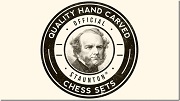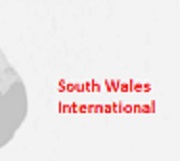Origins
The successes and failures of the first chess group at Wrexham which played in the 1866-7 tournament are not recorded and there is no evidence of a club being established in the town before 1886.
The club at Wrexham is not the oldest in North Wales, Ruabon having formed a club four years earlier; and for most of its history it has not been the strongest club in North Wales, Rhosllanerchrugog debatably having that honour; but throughout the turbulent history of North Wales chess the Wrexham club has remained a constant factor and at the hub of all chess activities.
There were certainly chess players in the town. “A Wrexham Chessplayer” was writing to the Illustrated London News as early as 5th May 1849; but sadly such correspondence in those days was mostly anonymous. One of them, H. Williams, played in the Postcard Match representing the United Kingdom against the United States, 1877-1881. He managed to win one of the four games that he played.
The chess club was founded in December 1886 and its 30 members paid two shillings and six pence a year membership. The new club was heralded by a notice in the Wrexham Advertiser:
“Lovers of the game will be glad to know that a Wrexham Chess Club has been formed at the Lion House, High Street, Wrexham. Mr. E. Lloyd Jones has been appointed Secretary. The next meeting is at 8 p.m. on Wednesday, 8th December.”
Development
In April, 1887, a rival chess club was formed within the town. The ‘Conservative Chess Club’ met at the Conservative Club in High Street, and there was considerable rivalry between the two clubs. Several matches were played between them with the Wrexham club winning on both occasions.
By October the same year the Conservative group appear to have lost their home for they met at the Maelor Hotel in Regent Street, a temperance establishment, and formed a Wrexham Chess Association, George Whitehouse acting as secretary. They made the hotel their new headquarters and again matches were held between them and the Wrexham Chess Club. The ‘Association’ appears to have gathered strength by the move for now they were able to defeat their rivals.
In January, 1888, the two clubs combined for a match against Ruabon, a venture which was enormously successful. In October the Club and Association amalgamated.
Sometime around 1891 the chess club disbanded. The reasons for this are not known but may have had something to do with the death of their secretary, Langshaw Rowland. The break in the club’s history was not long-lived and matches were again being played by December 1893. Apart from the World Wars, this is the only break in the club’s history.
The Chess Players’ Annual and Club Directory 1893/4 confirms the date of the club’s founding as 1886. It also gives some details about the club. The club membership fee was two shillings. The club met twice a week, on Wednesdays at Venn’s Restaurant in Overton Arcade, and on Fridays at the Lion House. Hon. George T. Kenyon M.P. was President and there were two secretaries, George S. Foyster of the National Provincial Bank and E. Lloyd Jones of Bury Street.
One complication in the 1890’s was that there was no single definitive version of the rules. Many clubs in the Directory therefore stated which version was in use. Otherwise problems could occur when players came to visit the club. Wrexham used the “Handbook” rules (from Staunton’s Chess Players’ Handbook). This was, perhaps, the most popular version but there was certainly no unanimity amongst the clubs listed.
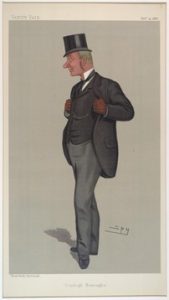
Wikipaedia
Hon. George T. Kenyon. Wrexham chess club’s first President.
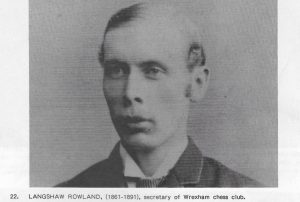 David Casteldine : Chess in North Wale
David Casteldine : Chess in North Wale
Langshaw Rowland 1861-1891
He was registered as a chemist in the town in 1883. The family business was established in 1810 and still exists today.
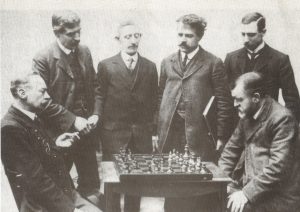 Photo: H. Weaver & Clwyd R.O.
Photo: H. Weaver & Clwyd R.O.
Wrexham club 1913. Winners of the Chambers Cup L-R L.B. Rowland, C. G. Caldecott,
H. E. Copleston, J. Taylor, H. Worley, G.Whitehouse.
Leonard B. Rowland (1863-1939), born and bred in Wrexham, was a pharmacist and served as mayor of the town several times before WW1. He was the younger brother of the club’s first secretary, Langshaw Rowland. Clement G. Caldecott (1861-1935) was also a chemist and originally was from Chester. George Whitehouse (1849-1916) was a coal merchant and brick manufacturer originally from Staffordshire; he was President of the North Wales Chess Association from its foundation until 1912.
Henry Copleston (1863-1938) was born in Liverpool and became a master painter. Caldecott with G. Clement, wrote chess articles for the Wrexham Advertiser between 1925 and 1936. He also served as secretary of the North Wales Association just prior to WW1.
George Whitehouse at this time was the strongest of the Wrexham players and played on one of the top boards for Denbighshire and North Wales. He won the earliest mentioned handicap tournament at the club 1890-1 and sometimes played number two to Locke Holt, but the latter died in 1907.
The early club was probably quite exclusive. One of the most senior club present-day players recalls the members’ consternation when a lady applied for membership in his early days with the club, only fifty years ago. After much agonising and lengthy discussion they decided it just would not be proper to admit lady members!
After the First World War there were two clubs again operating in the town. The old Chess Club met at the Wynnstay Hotel whilst a new club met at the Y.M.C.A. One can assume from parallel events in other parts of the Principality that these clubs represented the different classes of society. The new chess players, who had learnt the rudiments of the game whilst on active service, started their own clubs in the Y.M.C.A.s, works’ canteens, or village halls, whilst the more exclusive pre-war clubs were restricted generally to the local professional men. The two clubs at Wrexham amalgamated in 1921.
Apart from matches in the North Wales Championship, friendly fixtures were also arranged. A novelty in 1937 was a series of matches between members of the club representing the different residential areas of the town.
Between 1939 and 1943 activities at the chess club were once more at a standstill. There was however some chess action in the town. Early in the war, Royal Ordinance Factory No.35 was established on the Wrexham Industrial Estate. In 1941 ‘The 35 Club’ was formed which continued to operate until 1946, matches being played against both Rhos and Wrexham. A Mr. Pett was the person responsible for stimulating the game in the town during the war years.
Since the war the club has leaned heavily away from other North Wales interests and towards the Cheshire League.
The proximity of the club to Chester has led to a long and close association between the two. The Chester Y.M.C.A. Chess Club was founded in 1919 but matches were being played with an earlier club at Chester in 1898. In the 1920s many matches are recorded between Wrexham and Chester with honours fairly even. The Chester and District League was formed in 1954 and Wrexham was one of the founder members. The club won the league title in 1959 and was successful in winning the Second Division in 1964, 1966 and 1970. They won the main title again in 1982 and in 1986, whilst celebrating the centenary of the Wrexham club, they won the treble – Division One of the Chester & District League, the League’s Knock-out competition and the North wales Team Trophy. They won the Chester league repeatedly during the 1990s and usually also won the Knock-out.
During the period from 1994 to 1998, the club organised an International Grandmaster Tournament in Wrexham, sponsored by Owens Corning and supported by Wrexham Council.
The club currently boats Richard Dineley CM, David J. James FM and Charles Morris, 1990 Welsh champion, as their lead players and can rightly claim to be North Wales premier club.
Meeting Places
The club continued to meet at Venn’s Restaurant and at the Lion House until around Christmas 1890 when a room was found at the Maelor Hotel in Regent Street. In 1894 they are recorded as meeting at Jones’ Restaurant in High Street but by 1898 had settled at the Wynnstay Hotel. For the next twenty years the club appears to have flitted from one public house to another, depending on the function. They met at the Imperial Hotel for several simultaneous displays and annual meetings; and also at the Westminster Hotel and at the Wynnstay Hotel.

The Lion House, Wrexham (left). It eventually became home to a bank.
For a short spell in 1922-4 they met at Crane’s Building in Regent Street before returning again to the Wynnstay. Thereafter the club appears to have had an insatiable wander lust. In turn it was housed at Church House 1926, Y.M.C.A. 1927, Mine Workers’ Institute 1939, Wynnstay Hotel 1943, Central Cafe in Brook Street 1945, Y.M.C.A. 1947, Church House 1948, Highgate Inn (Nov.) 1948, Temple Row 1954, Garden Village Institute I960, Milk Bar in Abbott’s Street 1963, Red Lion Inn 1965, and finally Wrexham Sports Club 1970. The Wrexham ‘globe-trotters’ moved for many reasons which were usually related to finance.
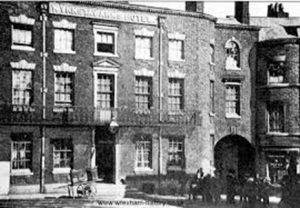
Wynnstay Arms Hotel 1905
Sometimes the club occupied two premises as in 1945 when the cafe was rented at a cost of ten shillings per night for playing matches, whilst other premises were used for occasional meetings. The move from Garden Village was forced by a drastic fall in club membership. The usual number registered was over twenty, but from 1958 to 1963 membership varied between 8 and 11. Garden Village was situated a short way out of town and it was felt that, unless premises were acquired in town, then the chess club would die.
Club Internal Competitions
The club promoted several internal competitions. A Club Championship was in being in 1922 but was poorly supported. A Silver King was purchased by the club in 1929 as a trophy for the tournament in order to stimulate interest and thereafter it appears to have been keenly contested. There was also an American Tournament and a Club Tournament. The latter was won in 1934 by Mr. A. E. Ball who played 87(!) games and scored 67.5% to secure victory. As the membership of the club at this time was just 14 one gets some indication of the keenness of the competition at the club.
A further boost to activities was the presentation of a chess board as a trophy in 1951 by Mr. Langshaw Rowland, which was duly dubbed the ‘Sir Leonard Board’ in memory of his father, a distinguished former member and mayor of the town for several years.
Club Champions
| 1922 | H. E. Coplestone | 1952 | J.M.Cudworth |
| 1923 | H. E. Coplestone | 1953 | J.M.Cudworth |
| 1924 | H. E. Coplestone | 1957 | L.L.Jones |
| 1930 | Sir L .B. Rowland | 1958 | L.L.Jones |
| 1931 | Sir L .B. Rowland | 1959 | L.L.Jones |
| 1932 | C. G. Caldecott | 1960 | A.Street |
| 1933 | E. L Rogers | 1961 | B.Tomkinson |
| 1934 | E. L Rogers | 1962 | Q.R.H.Dodd |
| 1935 | E. L Wilde | 1963 | B.Tomkinson |
| 1936 | L.Rowland | 1964 | Q.R.H.Dodd |
| 1937 | A.E.Ball | 1966 | B. Millward |
| 1938 | H.C.Rowland | 1967 | L. L. Jones |
| 1939 | E.L.Wilde | 1968 | Q.R.H.Dodd |
| 1944 | E.L.Wilde | 1970 | M. Davies |
| 1945 | R.K.Beesley | 1971 | W.C.Davies |
| 1946 | R.K.Beesley | 1972 | W.C.Davies |
| 1947 | D.E.Knight | 1973 | M. Hughes |
| 1949 | B. Tomkinson | 1974 | M. Hughes |
| 1950 | C. Roberts | 1975 | M. Hughes |
| 1951 | J.M.Cudworth (16 years old) |
The Players
The names of the club’s leading players are not well known in the South. The leading players before the First World War were Locke Holt, Sir Leonard Rowland and George Whitehouse. From match results alone Mr. Holt could lay claim to being the strongest player in North Wales during his time. He not only took on and beat players within the club and in neighbouring clubs but also beat the best that clubs such as Liverpool and Chester could offer. One of his rare defeats was to J. E. Parry of Shrewsbury and later Bangor.
The first really strong player in North Wales was Locke Holt (full name William Locke Holt). Born in Leigh, Lancashire in 1851, he moved to Wrexham around 1878 and was a key figure in the development of the club. Mr. Holt was a turner by trade and set up his own foundry at Rhostylln about 1902. When he died in 1907 a Leigh newspaper reported that, “a few years ago he defeated the Liverpool champion, he also won the ‘Dublin Mail’ Chess Competition, and Mr. Gunsberry (probably W.H.Gunston ed.) the well known chess champion said that Mr. Holt was the finest correspondence player in England.” Tim Harding shows him as the editor of “Wrexham Lantern and Tit-bits” from about 4th November 1882, but, if it still exists, it is probably in an archive collection.
The Dublin Evening Mail tournament was a postal chess competition and had started in 1889. He played in several postal events throughout the 1880s and took second prize in the second Preston Guardian tourney which was a strong knock-out event.
The same Leigh newspaper mentioned above said that Mr. Holt had been taken ill at work and the Doctor was called to his home although it was not expected that the illness was serious. Later however, Mr. Holt remarked to his son, “It’s Checkmate with me this time Will”. His son replied, “Oh no. It’s only check.” Locke Holt died the following day at the age of 57. To the end he could recognize a mating combination!
He and his son both feature as winners on the Ruabon Handicap Tournament Trophy. Handicap Tournaments were very popular up to the First World War and it was rare for strong players to ever meet weak opposition on even terms. A Handicap Tournament was inevitably the most popular event at any chess club. Another strong player, George Saint, won this trophy four times.
Parry himself became closely associated with chess in Wrexham and gave at least three simultaneous displays there in the twenties without losing a game. The club would give him 10s. 6d. for his services.
R. W. Egerton (from 1922) and K. H. Dodd (1960), both members of the Wrexham club served as Presidents of the North Wales Chess Association.
Lady members were a problem. In the 1950s when a lady applied for membership there was a lengthy discussion and a decision was reached that it would not be proper to admit lady members! More recently Womens’ International Master, Major Anne Sunnucks (British Ladies’ champion in 1957, 1958 and 1964), was a member, playing for at least one season in 1965.
There are two other individuals with connections to Wrexham who are well worth looking up. Frederick William Soames of Bryn Estyn (1857-1926), mayor of Wrexham 1891 and 1901, was Life-President of the club from the 1890s onwards. He ran a brewery in the town and was a great philanthropist. His story is told on the History of Wrexham website.
George Wyville Moses was born in Wrexham in 1888. His story is told in full on the excellent Yorkshire Chess History website. He played for Sheffield and Yorkshire and in a number of congresses.
Simultaneous Displays
There have been some superb simultaneous displays at Wrexham over the years. The earliest found to date was a visit of the British master Francis Lee in 1891 though no record of the result exists.
January 1898 J. H. Blackburne
This was a tremendous effort by the Maser. In the afternoon, at the Wynnstay Arms, he took on six of the best players selected from Wrexham, Rhos and Ellesmere clubs in a blindfold display, winning three, drawing two and having one game unfinished. The draws were achieved by Dr. G. F. Jones of Rhos and Dr. James J. Drinkwater. The unfinished game was against Locke Holt. The vanquished were George Saint (Ruabon), George Whitehouse (captain of Wrexham) and Colonel Hutton (Vice-President of Wrexham). In the evening he took on 30 local players, winning 22, drawing 7 and losing only to Locke Holt.
June 1908 E. Lasker
The World Champion took on 25 players, winning 19, drawing 5 and only drawing with T. O’Feeley of Gresford.
October 1910 I. Gunsberg
The Hungarian master who had narrowly lost to Steinitz in a battle for the world title in 1891, visited the town, drawing 2 and losing 3 out of 22 games played. The winners were George Saint and S. A. Duce of Ruabon and Schofield; Cross (Wrexham) and J. T. Edwards managed to draw. Another report shows a Clement Jones also drawing with the Master.
October 1919 J. R. Capablanca
Capablanca, who was World Champion 1921-27, came here to give a Simultaneous Display against members of Wrexham Chess Club and other local players at the Wynnstay Arms Hotel in the High Street. The North Wales Guardian of Friday October 31 1919 reported:
“The enterprise of the Wrexham Chess Club in inducing Senor Capablanca to visit the town was rewarded on Monday night by a successful exhibition. Thirty players from Wrexham, Ruabon, Overton, Rhos, Caergwle etc. took part, and quite a crowd of chess enthusiasts assembled in the Wynnstay Hotel Billiard Room and watched play from beginning to end. Mr. R. W. Egerton, captain of the Wrexham Chess Club, was the prime mover in the effort to obtain the champion’s presence. His Worship the Mayor, (Councillor L. B. Rowland) introduced him and Senor Capablanca having replied, the play started. The champion moved quickly from board to board with a nonchalant yet keen air and many players were soon in difficulty and resigned. In two hours and a quarter the games were over and without a win or a draw for the home team….”. A total of 26 players had to concede.
After annihilating the local players, Capablanca was entertained by the Yorke family at Erddig – his visit is mentioned in the diary of Mrs. Louisa Yorke for Monday 27 October 1919.
February 1922 B. Kostic
The Serbian Grandmaster won all 20 of the games played.
October 1923 A. Alekhine
Not learning from their experience the previous year, the North Walians lost all 32 games to the World Champion. This was the only time that Alekhine played in Wales.
March 1945 J. Mieses
The Master drew just one of about 30 games played.

David Castledine: Chess in North Wales
Jacques Mieses at Wrexham
There are suggestions that others have given displays at Wrexham – F. J. Lee in 1890 or 1891, E. Znosko-Borowsky 1934, and the American Frank Marshall in October 1912 – but no records have yet come to light.
More recently John Littlewood, Grandmaster Nigel Davies and Georgian Woman Grandmaster, Ketevan Arakamia, have given displays at the club.
THE INTERNATIONAL TOURNAMENTS (1994-98)
In 1994 Grandmaster Nigel Davies, who is one of Britain’s leading players, was living in Wrexham. In association with him and with the Wrexham Borough Council, the Club organised an International Tournament at Redwither Tower in Wrexham. The commercial sponsors were Owens Corning, who had a factory in the area. Following the success of the first event, the tournament was soon established as one of the four premier annual events of British chess – the others being the traditional Hastings Tournament (first played in 1895), the British Championship and the Isle of Man Open.
The Wrexham tournaments were traditional ten player all-play-all events. They were Category 7 tournaments on the international scale – intended for grandmasters, masters and others seeking these titles. An innovative feature was the first use in Britain at the international level of digital clocks with the “Fischer” incremental time control.
Over the five years the tournament was held players from Germany, Sweden, Czech Republic, Finland, Hungary, India, New Zealand, Netherlands, Denmark, Russia, USA, Iceland, England and Wales took part. The most eminent players to participate were David Bronstein, who drew a match for the World Championship in 1951 and Mark Taimanov, who famously lost to Bobby Fischer.
The tournament winners (from the UK unless stated otherwise) were:-
1994 1st N. Davies 7½ 2nd L. Karlsson (Sweden) 7
1995 1st J. Howell 6½ 2nd I. Csom (Hungary) & M. Pein 5½
1996 1st C. Ward 6½ 2nd N. Davies 6
1997 1st A. Kinsman 7 2nd M. Taimanov (Russia) 6½
1998 1st & 2nd = T. Thorhallsson (Iceland) & S. Brynell (Sweden) 6½
My thanks to R. Davies, D. Casteldine, M. Hughes and the late H. Weaver for help in putting this article together.




